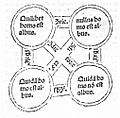Logic facts for kids
Logic is the study of how we think and reason. It helps us figure out if something is true or false. Logic is like a set of rules for good thinking.
For example, a famous thinker named Aristotle used logic to show things like this:
- All people are mortal (meaning they will die).
- Socrates is a person.
- Therefore, Socrates is mortal.
This is a simple example of a logical argument.
Contents
Using Symbols in Logic
Sometimes, people use symbols to make logic clearer. This is called symbolic logic. It's like using math symbols to represent ideas.
Here are some common symbols:
 means "and". It means both things are true.
means "and". It means both things are true. means "or". It means at least one of the things is true.
means "or". It means at least one of the things is true. means "implies" or "if... then...". It means if the first thing is true, then the second thing must also be true.
means "implies" or "if... then...". It means if the first thing is true, then the second thing must also be true. means "not". It means the opposite of something.
means "not". It means the opposite of something.
In logic, we talk about statements. A statement is a sentence that can be either true or false. For example, "The sky is blue" is a statement. "Are you hungry?" is not a statement because it's a question.
If someone makes a mistake in logic, it's called a "fallacy".
What is a Logical Proof?
A logical proof is like a step-by-step argument. It's a list of statements that show how one idea (the conclusion) comes from other ideas (the assumptions).
For example, you can prove that "Socrates is mortal" if you assume "Socrates is a man" and "All men are mortal." Each step in the proof must be true or follow from earlier true statements.
Some statements are always true, no matter what. For instance, "Either it is raining, or it is not raining" is always true. This type of statement is called a tautology.
How Logic is Used
Logic is used in many different areas:
Logic in Computers
Computers use logic all the time. When you write a computer program, you are giving the computer a set of logical instructions. This set of instructions is called an algorithm. An algorithm tells the computer exactly what to do and when to do it, step by step.
Logic in Math
Logic is very important in mathematics. Mathematicians use logic to create proofs. These proofs show that mathematical facts are correct and true. There's even a special part of math called mathematical logic that studies logic using mathematical tools.
Logic in Philosophy
Logic is also a big part of philosophy. Philosophers use logic to understand how we think, what is true, and how we can make good arguments. It helps them explore big questions about knowledge and reality.
Images for kids
-
Aristotle, a famous Greek philosopher (384–322 BCE).
See also
 In Spanish: Lógica para niños
In Spanish: Lógica para niños




